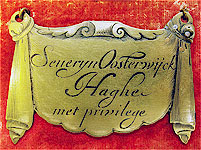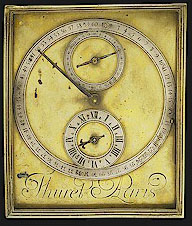 |
A Royal
'HAAGSE KLOK'
by: Keith Piggott. |
 |
|
|
 WHITESTONE'S
DISCOVERY
Back to Main Document. WHITESTONE'S
DISCOVERY
Back to Main Document. |
| |
|
|
Jean Claude Sabrier's & Sebastian Whitestone's
Discovery.
Subsequent to my drafting this review, Mr. Sebastian Whitestone
published an exciting discovery and a new thesis, “The Identification
and Attribution of Christiaan Huygens’ First Pendulum Clock”
(Antiquarian Horology, Dec. 2008. Click
here to view). In my 2005 paper, I had merely cited
earlier paradigms, also Huygens’ oddly disingenuous disclosure, and his
unfounded litigation against Douw. But Sebastian makes out the case for
an earlier French pendulum, by Isaac Thuret of Paris. He submits the
clock as physical evidence. It stands the test as remarkable and early
regulator. So might a Huygens-Thuret Contract now be found? [Thuret’s
pyramidal plumbs-crews are strangely reminiscent of the ill-starred Jan
van Call ‘prototype’, (see Sotheby’s, 16/10/86, Lot.128). In our
preview, Berry van Lieshout expressed his concerns at the Van Call’s
internal geometry. I am informed that forensic tests (to show it a fake)
have proven inconclusive; perhaps, that academic orphan should be
revisited].

Fig. 9
Isaac
Thuret's
recently
discovered
regulator
clock.
©
Picture, courtesy
Jean-Claude Sabrier.
|
|
Sebastian moves Huygens’ pendulum timeline back, to 1655. Is he
premature or perhaps mistaken about evidence of Cycloid-cheeks formerly
being mounted on Thuret’s back-cock? Cheeks were not part of the
presumed invention of Christmas Day 1656, only appearing in 1657, but
the Cycloid form did not appear before 1660.
Thuret’s suspended long-pendulum, with horizontal verge, nevertheless
was Huygens’ intellectual property; the “astronomers’ way”. (nb.
Johannes Hevellius, the Danzig astronomer, applied it differently,
setting his clock within his own suspended pendulum). Whereas my
“craft-way”, the pivoted pendulum (proposed by astronomer Galileo
Galilei for his mechanical pendulums of 1635 and 1642), was adopted by
Ahasuerus Fromanteel, then the Campani brothers c.1658.
Reflecting on the 1657 Contract. Sebastian’s thesis also does not affect
importance of Oosterwijck’s Royal Hague clock, in its paradigm of Hague
spring-clocks. I regard Oosterwijck’s clock with hour strike (which we
know as the English system), as the original on which the
‘Coster-Visbagh’ clocks were modelled, after Mayday of 1658, when the
secret changed hands.
My 2005 paper recalls Ahasuerus Fromanteel’s parallel contribution to
the pendulum. Huygens, rightly, was lionized for horological
achievements, but it takes nothing from him to credit Ahasuerus’
contemporary solution by his older craft way. Here, in evidence of a
Royal Oosterwijck, his influence is seen to extend deep into Coster’s
own workshop. And I also observe that the etymon of ‘secreet’ is not
Dutch but English. That conspicuous linguistic clue now assumes a new
significance to resolve this 352-year-old riddle.
If it can be proven that a Frenchman, Isaac Thuret, had applied Huygens’
pendulum before Coster, even before John Fromanteel's Contract, then
that would make any “Coster secret” seem even less dependable - at least
to this independent writer. |
|
 Sebastian Whitestone.
Sebastian Whitestone. |
|
|
 Copyright:
R.K.Piggott,
February 20, 2009. Copyright:
R.K.Piggott,
February 20, 2009. |
|
